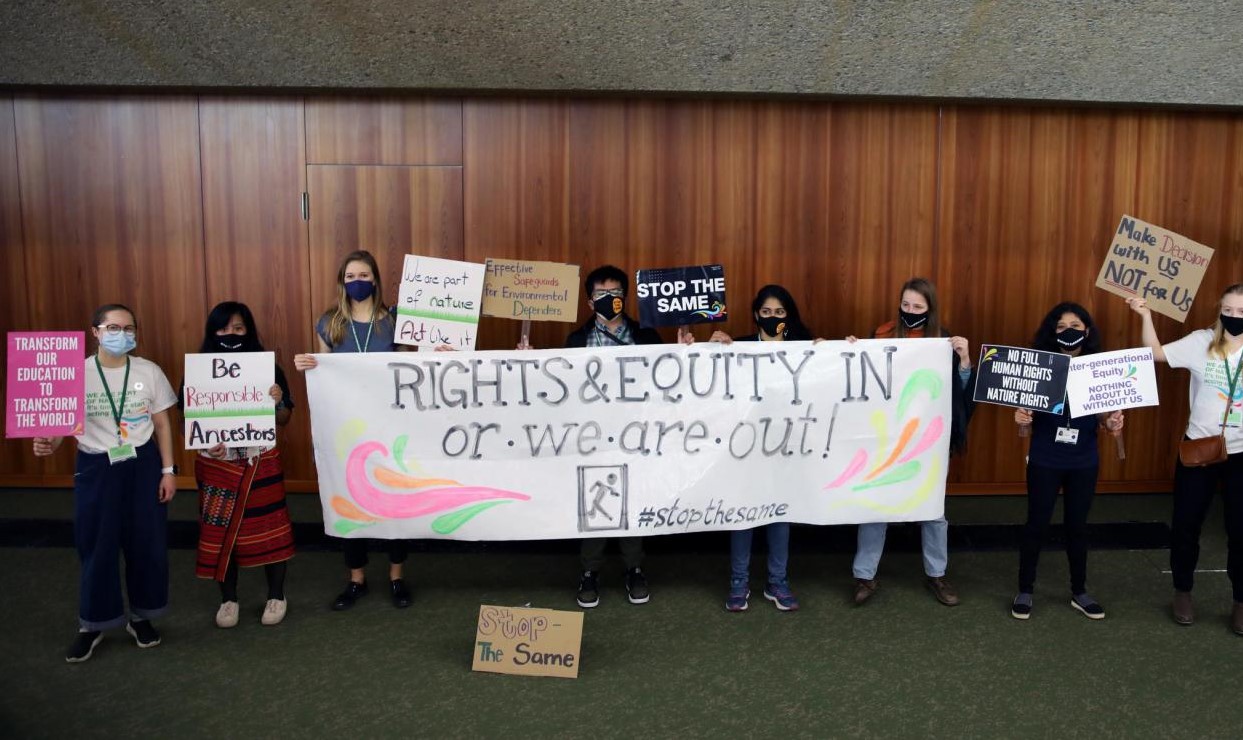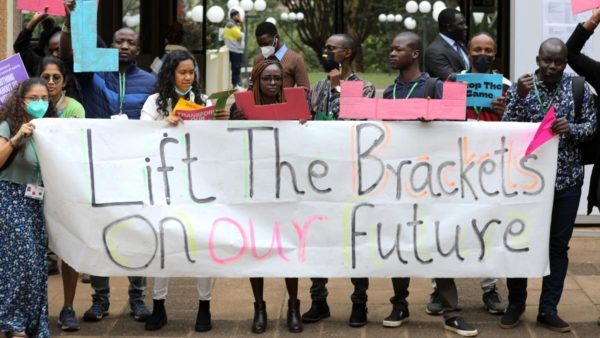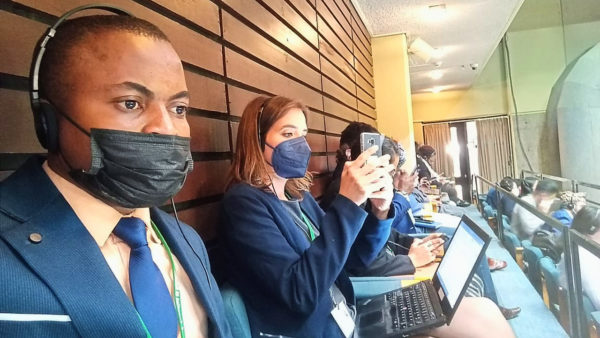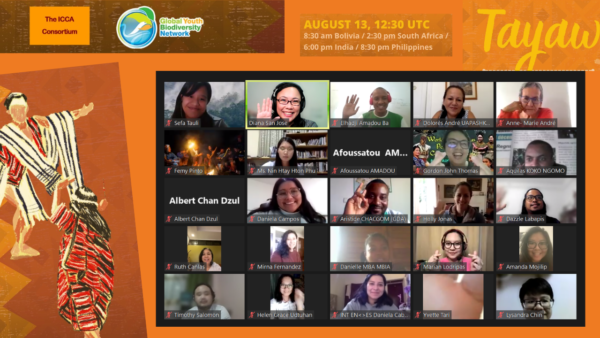In this World View article published in the peer-reviewed journal Nature Ecology & Evolution, Josefa Cariño Tauli shares a personal perspective, as a young Indigenous woman, on why it is so critical to heed long-standing calls for human rights, justice and equity in the post-2020 global biodiversity framework
First published on 07/27/2022
By Josefa Cariño Tauli (Global Youth Biodiversity Network; ICCA Consortium Honorary member and Co-chair of Youth for Territories of Life)
Reposted for non-commercial use from Nature Ecology & Evolution; originally published on 6 June 2022
There is a too-real dystopian fear that creeps up on you when you are a young Indigenous woman sitting in a room of the world’s decision-makers who are, in so many words, considering whether human rights are really relevant to the next long-term plan to safeguard life on Earth.
This is a feeling I do not wish on anyone, but that rose to the surface for me during the two and a half weeks in March when representatives of governments that ratified the UN Convention on Biological Diversity (CBD) met in Geneva to negotiate the post-2020 Global Biodiversity Framework (GBF), which lays down goals and targets for the world to address the biodiversity crisis within the next decades. It is a ‘post-2020’ plan that is still being negotiated in 2022, two years late and four years after the process started — stalled by the global COVID-19 pandemic, which itself is an example of the consequences of impending biodiversity collapse. Previous plans and targets have failed and there is simply no other choice: things absolutely must go right this time, and I say this with all the desperate hope of a generation with their future in the balance.

I have been participating in the development process for the GBF for the past four years as a member and, presently, policy co-coordinator of the Global Youth Biodiversity Network, the official coordination platform for youth participation in the CBD. During the very first day of the 2022 Geneva meetings, the youth delegation stood collectively in the venue holding a big banner that read “Rights and equity in, or we are out!”: a clear red line, calling for a rights-based approach to the conservation, sustainable use and equitable sharing of benefits from biodiversity. It was an action that signalled the positions and priorities of the global youth community that we represent as we participated in the negotiations that followed.
Calls for justice, equity and respect for human rights in the context of the environment have been resounding for a long time. They have been there from when Indigenous Peoples started demanding long-overdue recognition for their collective rights to their lands, territories and resources, which they have stewarded for millennia. They have been there as our communities risked, and still risk, everything to defend these lands from destructive extractive industries that wield money and power to gain even more money and power. They have been loud and clear for the past several years from young people storming the streets, calling for climate justice and intergenerational equity. These calls are not new but that does not make them any less relevant, because these problems of oppression and injustice persist. Not only do they persist, but they also permeate our economic systems, institutions, technological systems and governance, with deep roots that are causing the interrelated socio-ecological crises we face today. And I strongly believe one of the biggest differences that the GBF can make for biodiversity is to send a clear message to the world: that to address biodiversity loss, we must ensure justice and address inequalities.
My assessment is that the GBF is still nowhere near sending this message. There are those who are trying to improve it in this sense, but there still seems to be a lingering discomfort and confusion when it comes to human rights-based approaches. In some instances, the articulation of the importance of human rights can sound tentative or clumsy coming from seasoned scientific experts and biodiversity negotiators. Maybe it is because environmental problem-solvers have looked to the natural sciences for solutions for so long that the necessary social dimensions are still finding a place in their arsenals and vocabularies. Other situations are actively harmful, with proposals containing precisely the right words to get out of their human rights obligations. For the latter, I hope for the sake of this world that political pressure makes these governments change their tune. For the former, I have faith that the necessary emphasis will come with practice and reiteration.
It is simpler than we think: a human rights-based approach simply means that biodiversity policies, governance, management and implementation do not violate human rights, and actively seek ways to promote human rights. The details will follow by integrating existing human rights obligations within the framework, strengthening specific language in the targets where it is especially needed, and ensuring accountability by monitoring and measuring these elements — just as much as other elements of the targets must be monitored. For instance, we must not allow human rights violations to continue in the name of conservation. We must ensure that protected area targets safeguard Indigenous Peoples’ rights to their territories and to free, prior and informed consent. We must ensure and monitor meaningful participation, access to justice, and access to information of Indigenous peoples, women, children and youth — groups of people who are especially at risk from environmental harm, but who also have much to contribute in terms of solutions. We must hold businesses accountable for their negative impacts on the environment and consequently on human rights. And we must protect environmental defenders, aiming to reduce violence and killings against them year on year.
A human rights-based approach is not an add-on. It is a non-negotiable element that must be clearly stated throughout the text of the GBF. Not only is it a moral and legal obligation (which should be reason enough), but it is also the most effective way to conserve biodiversity. Promoting human rights produces real biodiversity outcomes and although we say this from lived experience, it is not just us saying so: so does the science. The IPCC’s Climate Change 2022: Impacts, Adaptation and Vulnerability report states that governance that prioritizes equity and justice in climate-adaptation planning and implementation leads to more effective and sustainable adaptation outcomes. And the IPBES Global Assessment Report on Biodiversity and Ecosystem Services states that we must leverage ensuring inclusive decision-making, fair and equitable benefit-sharing, and adherence to human rights in conservation decisions on the pathway towards the needed transformative change.
Alongside all this logic, my biggest appeal for a rights-based approach is a personal one. It has to do with that dystopian fear I described. I am no stranger to this undercurrent of fear. It is a fear of an unliveable future that many young people walk around with, often called eco-anxiety. It is a fear that I have learned to live with as a child of Indigenous peoples’ rights activists, who face constant threats from oppressive regimes for the work that they do. It is a fear that we must somehow painfully, but persistently, channel towards hope, to fuel our struggle for real and lasting solutions to the world’s deep-rooted problems, in all spaces possible.
All we ask when we ask for a human rights-based approach to protecting biodiversity is that we take away the fear that marginalized groups, including young people all over the world, live with every day. To the world’s decision-makers, is that really too much to ask?
Cite this article:
Tauli, J.C. Only a human rights-based approach will address biodiversity loss. Nat Ecol Evol (2022). https://doi.org/10.1038/s41559-022-01796-x
Josefa Cariño Tauli is an Ibaloi-Kankanaey Igorot Indigenous person from the Cordillera Region in the Northern Philippines. She is currently the policy co-coordinator for the Global Youth Biodiversity Network, the international coordination platform for youth participation in the UN CBD. Follow the Global Youth Biodiversity Network on Twitter, Facebook and Instagram.



